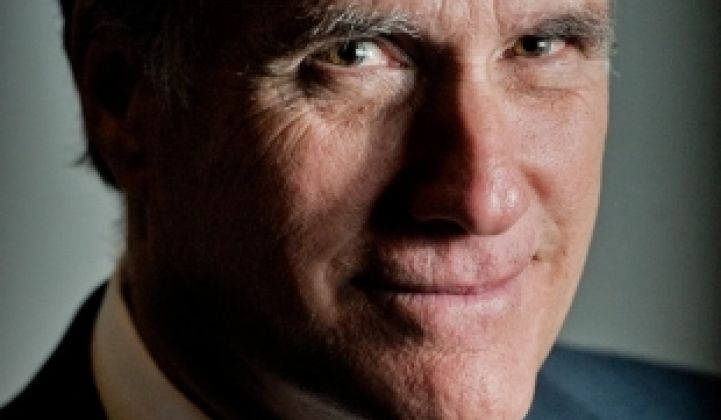Presidential candidate Mitt Romney’s spokesperson explained to ABC News on August 9 why the governor opposes extending the wind industry’s production tax credit (PTC), a 2.2 cents per kilowatt-hour support for projects’ first ten producing years, which is scheduled to expire December 31, 2012.
Even with “Obama’s approach of massive subsidies and handouts,” Amanda Henneberg told Devin Dwyer, the wind industry has “shed jobs while output has declined,” adding that “the one-year cost of extending the tax credit would be an estimated $12.2 billion.”
Henneberg’s "$12.2 billion" number references the Joint Committee on Taxation (JCT) estimate for the PTC. It is derived from the version of the PTC recently approved by the Senate Finance Committee in a 19-5 vote that included crucial support for the thirteen committee Democrats from Republican Senators Chuck Grassley (IA), Pat Roberts (KS), Mike Crapo (ID), Orrin Hatch (UT), Olympia Snow (ME) and John Thune (SD).
Welcomed as a lifeline by a wind industry relying on it to compete successfully against the subsidized fossil and nuclear industries, the proposed PTC extends the tax credit to projects under construction by December 31, 2013. It is, therefore, in reality at least a two-year extension and may have an even longer-lasting impact, depending on how 'under construction' is eventually defined.
What Henneberg got wrong is that the JCT estimate of $12.2 billion covers the cost of the PTC extension over the ten-year period extending to 2022. Contrary to Henneberg’s assertion, the $12.2 billion is not a “one-year cost” but a ten-year cost.
_540_449_80.jpg)
Henneberg’s misstatement echoed the popular misconception of renewables subsidies as unduly burdensome to taxpayers, whereas a recent GTM Stat of the Day showed that, between 2002 and 2008, renewables as a whole got $12.2 billion in government support ($6.2 billion in tax breaks) while the fossil fuel industries got $70.2 billion in federal support ($53.9 billion in tax breaks).
Henneberg was entirely correct about the wind industry shedding jobs.
As GTM just reported, wind’s installed capacity leapt from 25 gigawatts to 50 gigawatts and its domestic job count grew to 80,000 between 2008 and 2012 while its PTC was kept in place.
Since Congress opted not to extend the PTC into 2013, American Wind Energy Association CEO Denise Bode recently acknowledged, layoffs have already begun and wind supply chain facilities are shifting to serve other industries. Bode said the industry could lose 37,000 jobs if Congress decides not to act.
Henneberg’s reference to “wind’s output” is difficult to interpret, and she did not respond to GTM efforts to contact her for clarification. But it is hard to find an interpretation of 'output' that verifies what Henneberg claimed.
_540_449_80.jpg)
The current PTC provision requires projects to be in production by December 31, 2012. Wind developers have been rushing, since late last year, to get eligible projects in the ground and producing before the deadline. All metrics associated with installed capacity -- if that is what Henneberg meant by 'output' -- are therefore up for the year.
The twelve-month to eighteen-month lead time for the building of a wind project, industry watchers and analysts say, means 2013 will see a plunge in installations even if, as Senate Majority Leader Harry Reid (D-NV) recently promised, Congress finally extends the PTC later this year. But that metric of output, to date, is not down but up.
By other output measures, wind is doing even better. New technologies have significantly improved turbines’ ability to harvest even modest winds. Overall capacity factor is up. Levelized cost of electricity is now competitive with new coal. And wind and natural gas remain -- as they have for the last five years -- the top two resources of choice for builders of new capacity.
Insiders expect Senator Reid’s promise to extend the PTC to be kept only after the November election. If the outcome is a Romney presidency, Henneberg’s remarks about wind’s output may fall into the category of self-fulfilling prophecy.



